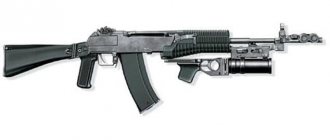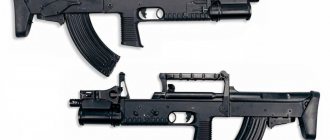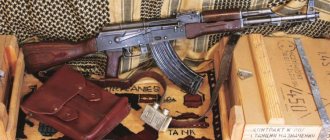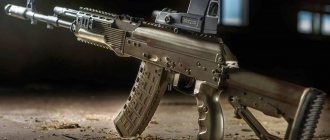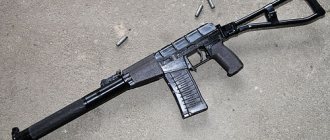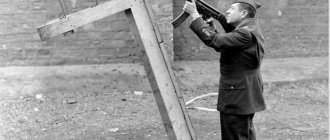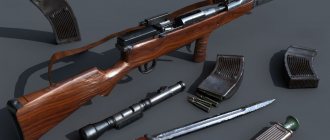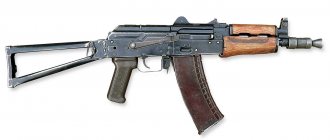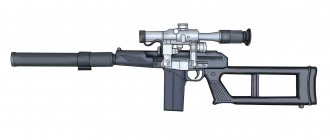| Modernized Kalashnikov assault rifle | |
| Type | Machine |
| A country | USSR USSR |
| Service history | |
| Years of use | 1959 - present |
| Adopted | 1959 |
| In service | see Operating countries |
| Wars and conflicts | Vietnam War Civil War in Laos Civil War in Cambodia Cambodian-Vietnamese conflict Sino-Vietnamese War Afghan War (1979-1989) Iran-Iraq War Gulf War Somalia Civil War Yugoslav Wars Croatian War Bosnian War First Chechen War Second Chechen War war War in Afghanistan (2001-2014) Iraq war Drug war in Mexico Civil war in Libya (2011) Civil war in Syria Armed conflict in eastern Ukraine Karabakh war |
| Production history | |
| Constructor | Kalashnikov, Mikhail Timofeevich |
| Designed by | 1950s |
| Manufacturer | Izhevsk Machine-Building Plant |
| Years of production | 1959 - 1977 (USSR) |
| Options | AKM AKMS AKMSU |
| Characteristics | |
| Weight, kg | without cartridges / loaded 3.1 / 3.6 (AKM) 3.3 / 3.8 (AKMS) empty / loaded magazine 0.17 / 0.66 (light alloy) 0.33 / 0.82 (steel) 0.26 (bayonet without scabbard)[1] |
| Length, mm | 880 / 1020 (with attached bayonet) 640 (AKMS with folded stock) |
| Barrel length, mm | 415 |
| Cartridge | 7.62x39mm (See Cartridges)[1] |
| Caliber, mm | 7,62 |
| Work principles | removal of powder gases, rotary bolt |
| Rate of fire, rounds/min | 40 (single combat) 100 (burst combat) ~600 (technical)[1] |
| Initial bullet speed, m/s | 715 |
| Sighting range, m | 1000[1] |
| Maximum range, m | 400 (actual fire) 1500 (lethal effect of a bullet) 3000 (flight of a bullet)[1] |
| Type of ammunition | detachable box magazine for 30 rounds (it is possible to use RPK magazines for 75 and 40 rounds) |
| Aim | sector (see sighting device) |
| Kalashnikov assault rifle modernized on Wikimedia Commons | |
7.62 mm Kalashnikov assault rifle, modernized
(AKM, Index GRAU -
6P1
) - an assault rifle, adopted for service in 1959 to replace the assault rifle (Index GRAU -
56-A-212
) and is its further development.
Differences from AK
AKM muzzle compensator.
Bayonet 6X3 for AKM, with a saw on the butt.
The main differences between the AKM and its predecessor[2]:
|
Options
- AKMS
(GRAU Index -
6P4
) - a variant of the AKM with a metal stock folding down under the forearm (adopted for service by order of the USSR Minister of Defense No. 232 of September 7, 1962). The stock mounting system has been changed compared to the AKS. The butt is raised to bring the resting point closer to the shooting line. The modification is designed specifically for paratroopers.
- AKML
(
6P1L
) - a variant of the AKM on which a dovetail-type side mount was installed for installing the NSP-3 night sight and a slot-shaped flash suppressor instead of the standard compensator (the flash suppressor was designed specifically for the “L” complex and differs from the SVD and PK/PKM flash suppressors; it was needed to protect the night sight from being illuminated by a flash from a shot).
The weight of the AKML rifle system with a sight and without ammunition is 6.26 kg. There was also a modification with a folding stock - AKMSL. AKMN
(
6P1N
) - a variant of the AKML, equipped with an NSP-3A sight. Modification with a folding stock - AKMSN. - AKMN-1 (6P1N-1)
- AKML variant, equipped with an NSPU sight. There is a modification with a folding stock. - AKMN-2 (6P1N-2)
- variant with NSPUM night sight. There is a modification with a folding stock.
Kalashnikov assault rifle
The Kalashnikov assault rifle has received a wide variety of evaluations throughout its long service.
At the time of creation and the next two to three decades
At the time of its birth, the AK was an effective weapon, far surpassing in all the main indicators the models of submachine guns chambered for pistol cartridges available at that time in the armed forces of the world, and at the same time being little inferior to automatic rifles chambered for rifle-machine-gun ammunition, having an advantage over them in compactness, weight and automatic fire efficiency. The cost of an AK with a milled receiver and wooden parts made of birch plywood in 1954 was 676 rubles[50].
Fyodor Tokarev at one time described the AK as distinguished by “reliability in operation, high accuracy and shooting accuracy, and relatively low weight.”
The high combat effectiveness of the weapon was confirmed during local conflicts of the post-war decades, including the Vietnam War.
The reliability and reliability of the weapon, due to the whole complex of technical solutions adopted in it, as well as, to a large extent, high quality manufacturing, are almost the standard for its class. It has been suggested that the AK is the most reliable military weapon since the Mauser 98 rifle[51]. Moreover, it is ensured even with the most careless and unskilled care, in the most difficult conditions.
At this moment
A modernized version of the AKS 74U assault rifle
As the weapon became obsolete, its shortcomings began to appear more and more - both characteristic of it and those identified over time in connection with changing requirements for small arms and the changing nature of combat operations. Even the latest modifications of the AK are generally outdated weapons, with virtually no reserves for significant modernization. The general obsolescence of the weapon determines many significant shortcomings.
First of all, the mass of the weapon is significant by modern standards, due to the widespread use of steel parts in its design. At the same time, the AK itself cannot be called overly heavy, however, any attempts to significantly modernize it - for example, lengthening and weighting the barrel to increase shooting accuracy, not to mention installing additional sighting devices - inevitably take its weight beyond the limits acceptable for military weapons, which is well demonstrated by the experience of creating and operating the Saiga and Vepr hunting carbines, as well as RPK machine guns. Attempts to lighten the weapon while maintaining an all-steel structure (that is, the existing production technology) lead to an unacceptable reduction in its service strength, which is partly proven by the negative operating experience of early batches of the AK74, the rigidity of the receivers of which turned out to be insufficient and required strengthening of the structure - that is, the limit is already here achieved and there are no reserves for modernization[51].
In addition, in an AK, the barrel is locked by the bolt using the cutouts of the receiver liner, and not the barrel extension, as in more modern models, which does not allow the receiver to be made from materials that are lighter and more technologically advanced to manufacture, although less durable. Two lugs are also a simple, but not optimal solution - even the bolt of an SVD rifle has three lugs, which ensure more uniform locking of the barrel and a smaller angle of rotation of the bolt, not to mention modern Western models, for which we are usually talking about at least six bolt lugs.
A significant drawback in modern conditions is the collapsible receiver with a detachable cover. This design makes it impossible to mount modern types of sights (collimator, optical, night) using Weaver or Picatinny rails: placing a heavy sight on a removable receiver cover is useless due to the presence of significant structural play. As a result, most AK-like weapons allow the installation of only a limited number of sight models that use a dovetail-type side bracket, which also shifts the center of gravity of the weapon to the left and does not allow the butt to be folded on those models where this is provided for by the design[ 51]. The only exceptions are rare variants such as the Polish Beryl assault rifle, which has a separate pedestal for the sighting bar, fixedly attached to the bottom of the receiver, or the bullpup South African “assault rifle” Vektor CR21, which has a collimator sight located on a bar attached to the standard AK sight base - with this arrangement it ends up right in the area of the shooter’s eyes. The first solution is quite palliative, it significantly complicates the assembly and disassembly of the weapon, and also increases its bulkiness and weight; the second is suitable only for weapons made according to the bullpup design. On the other hand, it is thanks to the presence of a removable receiver cover that the assembly and disassembly of the AK is quick and convenient, which also provides excellent access to the parts of the weapon when cleaning it[51].
Currently, other, more successful solutions to this problem have emerged. Thus, on the AK-12, as well as on hunting carbines of the Saiga system, the receiver cover is hinged upwards and forwards, which allows for the installation of modern sighting bars (on the AK-12 and “tactical” variants of the Saiga, this solution is already applied) without compromising access to weapon mechanisms.
All parts of the trigger mechanism are compactly assembled inside the receiver, thus playing the role of both the bolt box and the housing of the trigger mechanism (trigger box)[4]. By modern standards, this is a disadvantage of weapons, since in more modern systems (and even in the relatively old Soviet SVD and American M16), the trigger is usually made in the form of a separate, easily removable unit, allowing for quick replacement to obtain various modifications (self-loading, with the ability to fire in bursts fixed length, and so on), and in the case of the M16 platform - and modernization of weapons by installing a new receiver unit on the existing trigger unit (for example, to switch to a new caliber of ammunition), which is a very economical solution[52].
There is no need to talk about a deeper degree of modularity, characteristic of many modern small arms systems - for example, the use of quick-change barrels of various lengths - in relation to the AK, including even its most recent modifications.
The high reliability of the AK family, or more precisely, the methods used in its design to achieve it, is at the same time the reason for its significant shortcomings. The increased impulse of the gas venting mechanism, coupled with a gas piston fixedly attached to the bolt frame and large gaps between all parts, on the one hand, leads to the fact that the automatic weapon operates flawlessly even with heavy contamination (contamination is literally “blown out” from the receiver when fired); on the other hand, large gaps when the bolt group moves lead to the appearance of multidirectional lateral impulses that displace the machine gun from the aiming line in transverse directions, while the bolt frame comes to the rearmost position at a speed of the order of 5 m/s (for comparison, in systems with due to the “softer” operation of the automatic, even at the initial stage of the bolt moving back, this speed usually does not exceed 4 m/s), guaranteeing severe shaking of the weapon when firing, which significantly reduces the effectiveness of automatic fire. According to some of the available estimates, weapons of the AK family are not at all suitable for conducting effective aimed fire in bursts. This is also the reason for the relatively large bolt overhang, and therefore the longer receiver length to the detriment of the barrel length while maintaining the overall dimensions of the weapon. On the other hand, the AK bolt runs out completely inside the receiver, without involving the cavity of the butt, which makes it possible to make the latter foldable, reducing the dimensions of the weapon when carried.
Other shortcomings are less radical in nature and can be characterized more as individual characteristics of the sample[51].
One of the shortcomings of the AK, related to the design of its trigger, is often cited as the inconvenient location of the translator-safety (on the right side of the receiver, under the cutout for the cocking handle) and a clear click when removing the weapon from safety, supposedly unmasking the shooter before opening fire. However, it is noted that in combat conditions, if there is at least some probability of opening fire, there is no need to put the weapon on safety at all - even in the cocked state, the probability of an accidental shot, for example when the weapon is dropped, is practically zero.
However, the safety must be located separately, operate independently of the set fire mode, and be accessible for activation when the weapon is held by the pistol grip. On many foreign versions (Tantal, Valmet, Galil) and on the AEK-971 assault rifle, the safety switch is duplicated by a lever conveniently located on the left, which can significantly improve the ergonomics of the weapon, however, the ability to quickly open fire and select the fire mode (especially if there are three modes) - different functions. The solution could be this: the safety is closer to the handle, the fire mode translator is further away. The fuse is duplicated on both sides.
The AK trigger is considered to be quite tight, but it is noted that this can be easily corrected with simple skill[51].
The cocking handle located on the right is often considered a disadvantage of the AK family; however, this arrangement was at one time adopted based on very practical considerations: the handle located on the left, when carrying the weapon “on the chest” and moving it crawling, would rest against the shooter’s body, causing him significant discomfort. This was typical, for example, for the German MP40 submachine gun. The experimental Kalashnikov assault rifle of 1946 also had a handle located on the left, but the military commission considered it necessary to move it, like the fire safety switch, to the right. For example, on the foreign version of the Galil, for ease of cocking with the left hand, the handle is bent upward.
An AK magazine receiver without a developed neck has also often become the object of criticism as not being ergonomic - sometimes there are claims that it increases the time it takes to change a magazine by almost 2-3 times compared to a system with a neck. However, it is noted that the AK magazine is attached, although not in the most convenient way, but in any conditions, unlike, for example, the M16 rifle, the receiving neck of which in extreme conditions often gets filled with dirt, after which installing the magazine in it becomes very difficult. problematic[51]. In addition, in combat conditions, the practical rate of fire of a weapon is determined to a greater extent by the design of the magazine pouch than by the speed of its change. Also, changing the magazine on an AK can be done with either the left or the right hand, unlike machine guns with a neck, where a button located on only one side is usually used to change the magazine.
The ergonomics of all AK variants have often been the subject of criticism. The AK stock is considered too short, and the handguard is considered too “elegant”, but one must keep in mind that this weapon was created for relatively short military personnel of the 1940s, as well as taking into account its use in winter clothing and gloves. The situation could be partially corrected by a removable rubber butt pad, versions of which are widely offered on the civilian market[51]. In Russian special forces units and in the civilian market, it is very common to use non-serial versions of stocks, pistol grips, and so on on various AKs, which increases the ease of use of weapons, although it does not solve the problem in itself and leads to a significant increase in its cost.
Versions with a folding stock are not comfortable to carry in the folded position on the chest and on the back, since the stock folds to the left, unlike, for example, the Israeli Galil, which is derived from the AK. The shutter lever and the cartridge ejection window in the case of the butt folded to the right must be free for firing, as well as the safety catch. This proved to be a problem for the AK due to the safety on the right side.
Factory AK sights from a modern point of view should be considered quite rough, and a short sighting line (the distance between the front sight and the rear sight slot) does not contribute to high shooting accuracy. Most of the significantly redesigned foreign variants based on the AK first of all received just more advanced sighting devices, and in most cases - with a completely diopter type located close to the shooter’s eye (for example, see). On the other hand, compared to the diopter, which has real advantages only when shooting at medium-long ranges, the “open” AK sight provides faster transfer of fire from one target to another and is more convenient when conducting automatic fire, since it covers the target less[51 ].
The first versions of the Kalashnikov assault rifle did not have rails for mounting optical sights. The ability to install a rail for mounting optical sights appeared only on the AK-74M modification. The installed bar increases the time of assembly and disassembly of the weapon and makes it impossible to fold the butt to the left.
The accuracy of the weapon’s fire was not its strong point from the very moment it was put into service, and, despite the constant increase in this characteristic during modernization, it remained at a lower level than that of similar foreign models. However, in general it can be considered acceptable for military weapons chambered for this cartridge. For example, according to data obtained abroad, AKs with a milled receiver (that is, an early 7.62 mm modification) regularly produced groups of hits with a diameter of 2-3.5 inches (~5-9 cm) at 100 yards (90 m) with single shots ). The effective range in the hands of an experienced shooter was up to 400 yards (approximately 350 m), and at this distance the dispersion diameter was approximately 7 inches (~18 cm), that is, a quite acceptable value for hitting a single person. Weapons chambered for low-pulse cartridges have even better characteristics[51].
In general, although the AK, of course, has numerous positive qualities and will be suitable for the armament of countries in which they are accustomed to it for a long time, there is an obvious need to replace it with more modern models, moreover, having radical differences in design that would make it possible not to repeat the fundamental principles described above disadvantages of the outdated system[51].
Prospects for modernization
Additional information: AK-12
Izhmash’s work on deep modernization of the machine gun began in 2011. It was decided to take the path of modernization, rather than creating new weapons, for a number of reasons. Among them, the need to maintain reliability (stable operation after impacts, falls), price range (close to the cost of existing models of the Kalashnikov assault rifle), ease of use and the ability to operate in emergency conditions (humidity, dirt, dust, etc.) stand out.
The new model of the fifth generation (the first generation includes AK, the second - AKM, the third - AK-74, the fourth - AK-74M and the “hundredth series”, which are very close) was called AK-12, it was first presented at review in early 2012. The general director of Izhmash, in an interview with Lenta.ru, said that this is not just an improved model, but a fundamentally different machine with a different design and other capabilities. Work on it continues to this day, but it can already be said that many of the shortcomings inherent in previous AK models have been eliminated[52].
Modernization kit for Kalashnikov assault rifles “Kobves”, at the Arms&Hunter 2015 exhibition
First of all, this concerns the installation of a Picatinny rail for attaching sights (collimator, optical, night), tactical flashlight, target designator and other accessories. The AK-74M sample had a side rail for additional equipment, but it was impossible to install many devices on it, and when removing and installing them, it was necessary to re-shoot the weapon. The AK-12 has a built-in Picatinny rail, it is securely fastened and stable, so as not to have to shoot and effectively hit the target at long ranges. This was achieved by changing the cover, which became stiffer and is attached in the front and back in such a way that there are no backlashes. This also allows you to avoid leash when shooting and when temperature changes. The goal is also to improve the accuracy and accuracy of both single fire and automatic fire, as well as to reduce the recoil shoulder by lowering the barrel relative to where the weapon is held in the hands. For this purpose, a new barrel is being developed, and various versions of manufacturing, technology and rifling design are being considered. Based on the test results, the best option will be selected[52].
Many other components have been revised - the locking mechanism, automation, and the trigger mechanism to reduce recoil. Using modern surface treatment technologies, specialists are working to reduce the mass and speed of movement of the bolt group, while maintaining and even increasing the rate of fire. A telescopic folding stock has been developed, adjusted to the anthropometric characteristics of the fighter. To reduce bounce, the muzzle brake-compensator has been improved. A three-shot burst cut-off appeared so that a less experienced shooter could use ammunition more carefully by shooting in short bursts[52].
Work is also underway on the so-called “two-handedness” of the weapon. Now, releasing the safety, controlling fire modes, ejecting the magazine, cocking the bolt - all this in the AK-12 can be done on the left or right side at the discretion of the shooter. It is possible to position the cocking handle simultaneously on both the right and left [52].
Based on the AK-12, it was planned to produce a whole range of products - an assault rifle, a shortened machine gun, a submachine gun, a semi-automatic sniper rifle, a light machine gun and civilian versions of these weapons[52].
In 2012, at the test stage with the participation of experts from law enforcement agencies, very positive reviews were expressed regarding the AK-12. The Ministry of Internal Affairs and the Ministry of Defense of Russia are showing interest in the machine gun, and demonstration shooting was planned for the end of May 2012 for the leadership of the Russian defense department[52].
At the moment, significant stocks of Kalashnikov AK-74 assault rifles have accumulated in the warehouses of the Russian Ministry of Defense, the disposal of which is both unprofitable and irrational. In order to use these reserves more efficiently, Izhmash has worked on various options for upgrading the machine. The designers rejected the initial costly options with complex disassembly and complete replacement of many components, and at the moment the most promising option seems to be an inexpensive modernization with the replacement of the cover to which the Picatinny rails and forend will be attached, and the optional supply of a folding stock from the AK-12 with adjustment flight, replacement of the backplate and cheek. The modernized version will have to meet the requirements of the Ministry of Defense both in design and from the standpoint of economic efficiency[52].
Characteristics
Direct shot range from AKM:
- along the chest figure - 350 m,
- according to a running figure - 525 m.
Concentrated fire is carried out at a distance:
- for ground targets - up to 800 m,
- for air targets - up to 500 m.
Combat rate of fire is:
- when firing single shots - up to 40 rounds per minute,
- when firing in bursts - up to 100 rounds per minute.
The bullet retains its lethal effect at a distance of up to 1500 m. The muzzle energy of the bullet is 2030 (207 kgf m) [1].
Normal combat requirements for AKM[1]:
- all four holes fit into a circle with a diameter of 15 cm;
- the average point of impact deviates from the control point by no more than 5 cm in any direction.
Combat testing is carried out by firing single shots at a test target or a black rectangle 35 cm high and 25 cm wide, mounted on a white shield 1 m high and 0.5 m wide. Firing range - 100 m, position - prone, automatic - with a compensator without bayonet, cartridges - with an ordinary bullet, sight - 3.
| Indicators of the total dispersion of bullets with a steel core when firing in short bursts from an AKM reduced to normal combat [1]: | ||||||
| Firing range, m | Median deviations in height, cm | Median deviations in width, cm | Core stripes in height, cm | Core stripes width, cm | Bullet energy | |
| 100 | 8 | 11 | 24 | 34 | 1540 | |
| 200 | 15 | 22 | 46 | 68 | 1147 | |
| 300 | 23 | 33 | 70 | 101 | 843 | |
| 400 | 31 | 44 | 95 | 135 | 618 | |
| 500 | 39 | 56 | 119 | 171 | 461 | |
| 600 | 47 | 67 | 144 | 205 | 363 | |
| 700 | 55 | 78 | 169 | 239 | 314 | |
| 800 | 64 | 90 | 196 | 275 | 284 | |
Where the median deviation is half the width of the central scattering band, containing 50% of all hits, and the core band is the scattering band, containing 70% of the hits [4]. The total deviation includes the deviations of bullets and average impact points[1].
Thanks to the applied improvements, the dispersion of the height of hits relative to the AK has decreased. For example, the total median deviations at a distance of 800 m (vertical and width):
- — 76 and 89 cm[5]
- AKM - 64 and 90 cm[1]
For comparison:
- RPK - 68 and 67 cm
- RPD - 46 and 43 cm[6]
- SKS - 38 and 29 cm[7]
| Weapon | Ammunition | Cartridge weight | Weight of loaded magazine | Maximum amount of ammunition per 10 kg |
| AK-47 (1949) | 7.62 × 39 mm | 16.2 g | 30 patr. magazine - 0.82 kg | 12 magazines - 9.2 kg for 360 rounds[8] |
| M14 (1959) | 7.62×51mm NATO | 25.4 g | 20 patr. magazine - 0.75 kg | 13 magazines - 9.7 kg for 260 rounds[8] |
| AKM (1959) | 7.62 × 39 mm | 16.2 g | 30 patr. magazine - 0.66 kg[1] | 15 magazines - 9.9 kg for 450 rounds |
| M16 (1962) | 5.56×45mm NATO (.223 Remington) | 11.8 g | 20 patr. magazine - 0.32 kg | 31 magazines - 9.93 kg for 620 rounds[8] |
Description of the cold AKMS SKh assault rifle (Kalashnikov, signal)
Promotion in honor of the holidays, when you buy a cooled OS AK 103 SHP and 200 rounds of ammunition, another 200 rounds will be given as a gift . (The price for this promotion in total for 400 rounds of ammunition is 6,000 rubles, i.e. 15 rubles per piece)
This is a modernized Kalashnikov signal assault rifle with a folding stock, firing in both single and automatic modes.
The machine gun is made from a decommissioned combat model and fires 7.62*39 mm caliber cartridges, with a rate of fire of up to 600 rounds per minute (in practice, with the replacement of horns, up to 100 shots are obtained).
The Kalashnikov AKMS SKh assault rifle is sold without a license!
The handle of the machine gun is made of plastic, while the fore-end and gas chamber lining are made of natural wood. All wooden parts of AKMS CX are varnished for greater safety and increased service life.
The total length of the machine is 875 mm and weighs 3.5 kg. This is one of the most reliable machines in the world, which rightfully deserves this title. Adopted into service in almost 3 dozen countries.
The machine's magazine holds 10 rounds (because the manufacturer Molot Arms installed a limiter), but if you disassemble the magazine and remove the limiter (as shown in the video with a spare magazine for an AK from Popadiv10.RU), then as many as 32 rounds .
To prevent the use of live ammunition, Molot Arms performed the following cooling modifications:
1) The AKSM barrel was pinned to prevent the passage of solid objects through it.
Assembly and disassembly of the AKMS signal machine occurs in the same way as for the combat one, even the bolt is not welded to the bolt frame with a gas piston.
The Popadiv10.RU store recommends the AKMS assault rifle. The model is externally indistinguishable from the original and can be used as equipment for feature films, theatrical performances and any other events where imitation of combat shots is necessary.
The manufacturer stated that the modernized Kalashnikov assault rifle, with a folding stock, is suitable for the military-patriotic education of young people, will be an excellent addition to any collection and will help drive away evil dogs in case of emergency. If necessary, it can be used for self-defense, since the sound of falling cartridges can stop most attackers.
Device
A Romanian soldier disassembles his PM md for cleaning.
65 (licensed copy of AKM) AKM consists of the following main parts and mechanisms:
- barrel with receiver, sighting device and butt;
- compensator (in models from the 1960s)[2];
- receiver cover;
- bolt carrier with gas piston;
- gate;
- return mechanism;
- gas tube with receiver lining;
- trigger mechanism;
- forend;
- shop;
- bayonet knife.
The AKM kit includes: a cleaning rod and a pencil case with accessories (wiping, brush, screwdriver, drift, pin, oil can), a belt and a bag for carrying magazines. The AKMS kit additionally includes a case for the machine gun with a pocket for the magazine.
Sighting device
The AKM sighting device consists of a front sight and a sight, which in turn consists of a sight block, a leaf spring, a sighting bar and a clamp. On the sighting bar there is a scale with divisions from 1 to 10 (firing range in hundreds of meters) and the letter “P” (permanent sight setting, corresponding to sight 3).
Late-release assault rifles are equipped with devices for shooting at night (self-luminous attachment), consisting of a folding rear sight with a wide slot (installed on the sighting bar) and a wide front sight (attached to the front sight of the weapon from above), on which luminous dots are applied. This device does not separate during operation - when shooting during the day, the front sight and rear sight are folded down without interfering with the use of standard sighting devices.
AK-9 assault rifle
Subscribe:
Telegram, Facebook, OK.ru, VKontakte
A shortened AK-9 assault rifle for arming special forces of the armed forces and the Ministry of Internal Affairs. A silent, flameless, compact machine gun for the covert destruction of various emerging targets and unarmored military equipment at ranges of up to 400 m.
In the second half of the 1980s, designers of the Central Research Institute TochMash developed two versions of a single system of “silent” weapons, unified in parts and components and intended for silent and flameless firing at a range of up to 400 meters. The system of “silent” special-purpose weapons was represented by the special sniper rifle VSS “Vintorez” and the special assault rifle AS “Val”, which in 1987 were adopted by various special forces units of the USSR.
During their operation, some shortcomings were revealed:
short resource (5000 shots); large muffler; impossibility of shooting without a silencer; the presence in the muffler design of a spring that is separated during disassembly and therefore often lost; the need for cleaning after minor shooting;
high (compared to Kalashnikov assault rifles) cost.
Taking this into account, at the beginning of the first decade of the 21st century, OJSC Concern Izhmash proactively began work on creating a new silent, flameless, compact machine gun, designated AK-9, designed for the covert destruction of various emerging, moving, open and camouflaged, single and group targets (including those protected by level II body armor) and unarmored military equipment at ranges up to 400 m.
The AK-9 assault rifle is built on the basis of the design of the “hundredth series” of Kalashnikov assault rifles, a feature of which was the use of special 9-mm (9x39) cartridges 7N9, 7N12 (SP-5, SP-6) with subsonic bullet speed (SP-5, SP- 6).
In terms of design, the AK-9 generally follows the design of the AK-74M assault rifle, differing in the shortened gas engine and barrel components.
May have various modifications. It provides mounts for an underbarrel grenade launcher, laser sight, tactical flashlights and other devices.
A quick-detachable silent and flameless firing device can be installed on the barrel of the machine gun. Shooting is possible both with and without a silencer.
The weapon is fed with ammunition from detachable box magazines with a capacity of 20 rounds.
The trigger mechanism allows firing single shots and in fully automatic mode. The fuse—the firing mode translator—is similar to that in the Kalashnikov assault rifle and is located on the right side of the weapon.
On the left side of the receiver there is a standard rail for installing optical collimator and night sights.
The assault rifle can be equipped with a plastic folding stock with a cleaning rod similar to the AK-74M assault rifle, or a metal frame stock similar to the AKS-74 assault rifle, an ergonomic handle, and a special forend with Picatinny rail-type guides for installing additional equipment (fire control handles, tactical flashlight, laser target designator).
The weapon has improved plastic fittings. Ergonomic pistol grips and buttstock are made of impact-resistant plastic.
The AK-9 assault rifle was primarily developed to arm special units of the Ministry of Internal Affairs and the Russian Army.
In 2009, the silent, flameless rifle system AK-9 was demonstrated to the general public at the ROST-2009 exhibition. At the same time, pilot serial production of this machine was announced.
Like all Kalashnikov assault rifles, the AK-9 is distinguished by its reliability and ease of use, it has a high degree of unification with the AK series assault rifles, which ensures uniformity of weapon handling techniques, and allows the manufacturer to carry out mass production with maximum use of equipment, tooling and standard technological manufacturing processes of AK assault rifles.
Comparative tests of the AK-9 have shown that the assault rifle is superior to the Val (AS) - Vintorez (VSS) complex in terms of shot sound level, dispersion characteristics, versatility of use and some other indicators. During trial operation, the weight of the AK-9 was increased compared to the AC, but at the same time, the ease of use of the machine gun, the high efficiency and small dimensions of the muffler, and the ability to use the machine gun without a muffler to accompany and protect cargo and people were noted.
Based on the results of trial operation, a modernized model of the assault rifle was proposed, in which the weight was reduced by 400 g (without loss of reliability), the length of the aiming line was increased by 25%, and the rear sight was moved to the receiver cover, similar to the AKS74U assault rifle.
Join us! It's not boring with us:
Telegram, Facebook, , VKontakte
Topics: Kalashnikov assault rifle
Automation operating principle
The operation of AKM automation is based on the use of the energy of powder gases removed from the barrel bore. When fired, part of the powder gases that push the bullet is directed through a hole in the barrel wall into the gas chamber, pressing on the front wall of the gas piston, throwing the piston and bolt frame with the bolt to the rear position. The bolt opens the barrel, the pressure of the powder gases removes the cartridge case from the chamber and throws it out. The bolt frame compresses the return spring and cocks the self-timer.
Under the action of the return mechanism, the bolt frame and bolt return to the forward position. The bolt forces a new cartridge into the chamber and closes the barrel. The bolt frame removes the self-timer sear from under the self-timer cocking of the trigger.
The bolt is locked by turning to the right and, as a result, by moving its lugs past the lugs of the receiver.
The machine gun is an amphibian. The main “miracle weapon” of Russia
In 2013, official information appeared in the media about the created amphibious assault rifle, which has no analogues anywhere in the world. This invention became a worldwide sensation because the weapon was designed to shoot equally well in the air and underwater. Experts assured that it is in no way inferior to the latest modifications of the AK, and in a number of key characteristics it is even ahead of currently created types of Russian and foreign assault rifles. At the beginning of July, the model was first demonstrated at the BMSM 2013 salon.
What happened in the Soviet Union
Since the 70s of the last century, designers have been working on the creation of an underwater machine gun and a machine gun. The weapon was invented with the aim of providing it to scuba divers to destroy surface and underwater targets. Vladimir Simonov began developing an underwater complex, which included AG-022. In 1975, after a series of tests, the model was adopted by the USSR Navy, designated as “5-66 mm special underwater assault rifle - APS.” It was then that the beginning of automatic small arms, effective for use under water, was laid.
Soon the technical characteristics of the agro-industrial complex turned out to be not so impressive for the inventors and they moved on. Under the leadership of Doctor of Technical Sciences Yuri Danilov, the APS was completely modernized and a new multi-purpose automatic machine ASM-DT was born. It provided a successful attack under water with 5.45 mm cartridges and differed from the APS in that it was rifled. The patent for the invention was submitted by the Tula Technological Institute of Mechanical Engineering in the late 90s.
Yuri Danilov worked on the future brainchild for a long time. It took years to change the trigger mechanism, transform the bolt and bolt frame. Also, thanks to Danilov, the machine gun adapted to changing magazines directly under water. Subsequently, the model was improved through the introduction of a laser sight and a night vision device. According to the inventor himself, the management of the Tula Institute always provided support in the implementation of the planned development.
What is a “miracle weapon”
Simonov's assault rifle remained the only one of its kind. APS was successful underwater at a distance of up to 30 meters and this was enough, but aerial shots did not exceed 100 meters. For this very reason, fighters always took with them an APS and a variant for ground shooting.
The machine gun that emerged in Tula became the very alternative that replaced Simonov’s brainchild. ASM-DT was otherwise called “Sea Lion”. Thanks to a number of improvements, it was possible to achieve the desired effect that the APS lacked. The problem that nevertheless arose before the inventor and his team was special cartridges with a very high elongation bullet. It is for this reason that we had to resort to large-sized magazines, which increased the weight of the kit, thereby creating unnecessary discomfort.
As a result, Danilov developed a new model of a double-medium ADS assault rifle, which had the ability to fire MPS cartridges under water and 5.45 x 39 on land. However, as before, weapons continued to be equipped with various types of stores. When the inventor was asked why the machine became “two-medium”, he answered the following:
“The fact is that combat swimmers perform up to 90% of operations on land, and their standard weapon - the APS assault rifle - although not bad under water, is completely useless on the shore. The needle bullet is balanced for water, which is 800 times denser than air. On land, the bullet loses stability and begins to tumble. In short, from a distance of 50 steps, hitting a shield measuring one meter by one meter is a big problem.”
The new machine gun was superior to the legendary AK-74. To visually see the combat effectiveness of the weapon under water, it was tested in a hydropath. AFM was the best in the business, but needed improvement.
What has changed in "Sea Lion"
Since for a sufficient amount of time the weapon included two types of magazines, experts thought about creating a universal machine gun that would be used as a similar underwater machine gun. The new 53 mm long bullet behaved as confidently underwater as on land. In 2005, this was achieved thanks to the fact that a special “drowning” of the bullet in the cartridge was carried out. A year later, the design of the 5.45 x 39 PSP underwater cartridge was patented.
In 2009, the design team studied the possibility of firing 5.56 mm caliber cartridges from the ADS. To achieve this goal it was only necessary to change the barrel. After a series of test tests, the model proved its significant superiority over the AKM, AK-74, AK-105 and the famous US M-16 rifle. From the parts where the machine was transferred for operation, only positive reviews came, since the ADS had become truly universal and compact.
Over the years, the development of domestic designers has been subject to “attacks” from potential exporters. They repeatedly tried to buy the idea of a weapon from Danilov. The inventor was visited by representatives from the Baltic countries, Korea and India. But none of them received approval to purchase the developments.
What makes an “amphibian” different?
The amphibious assault rifle is equipped with a mode switch for the gas release mechanism with a 40-mm under-barrel grenade launcher. The cartridge cases are extracted using a special forward channel. Below are the tactical and technical indicators :
• Weight, kg: 4.6 (with grenade launcher)
• Length, mm 660
• Barrel length, mm 415
• Cartridge: 5.45×39 mm (PSP and PSP-U for underwater shooting, 7N6, 7N10 and 7N22 for air shooting, VOG-25 (grenade launcher)
• Caliber, mm: 5.45 / 40 (grenade launcher)
Work principles:
• Powder gas removal, rotary bolt
• Rate of fire, rounds/min: 600-800
• Initial bullet speed, m/s: 900 (7N6) / 333 (PSP) / 430 (PSP-U)
• Sighting range, m: 600 (on land) / 25 (in water) / 400 (grenade launcher)
• Maximum range, m: 25 (at a depth of 5 m) / 18 (at a depth of 20 m)
Type of ammunition:
• sector magazine for 30 rounds
Aim:
• diopter, folding grenade launcher, there is a mount for installing various sights.
What's next
In 2014, the amphibious assault rifle was first presented at the foreign exhibition Defexpo 2014 in India. As ITAR-TASS reported, the developer at the event was a branch of the Instrument Engineering Design Bureau TsKIB SOO. Early that year, according to Rostec, the model was presented to President Vladimir Putin during his visit to Tula. The ADS was also exhibited in the UAE at IDEX 2020. Then the director of the Tula branch of the KBP said that in the current year, 2016, serial production and supply of weapons would begin and an important remark was made regarding the fact that foreign corporations are showing great interest in the Marine lion."
For a long time, Danilov’s development was kept classified as “Secret”; only a couple of years ago they started talking about it publicly. The lack of any deliveries or any publicity is explained by a serious decline in funding in the army and navy in the 90s and early 2000s, which made it impossible to declare a technical achievement. The introduction of an “amphibian” into law enforcement agencies will reveal all the cards that were once at stake in the name of a unique machine model.
Ammo
The AKM is fired using 1943 model cartridges (7.62×39 mm) with the following types of bullets[1]:
- an ordinary one with a steel core
is designed to defeat enemy personnel located openly or behind obstacles pierced by a bullet. The shell is steel covered with tombac, the core is steel, and there is a lead jacket between the shell and the core. Has no distinctive coloring. - The tracer
is designed for target designation and fire adjustment at distances of up to 800 m, as well as defeating enemy personnel. The core consists of an alloy of lead and antimony, behind which there is a cup with a pressed tracer compound. The color of the bullet is green. - armor-piercing incendiary
is designed to ignite flammable liquids, as well as defeat manpower located behind lightly armored shelters at ranges of up to 300 m. The shell is with a tombak tip, the core is steel with a lead jacket. Behind the core in a lead pan there is an incendiary composition. The color of the head part is black with a red belt.
Assembly/disassembly
Partial disassembly of the machine is carried out for cleaning, lubrication and inspection in the following order:
- separating the magazine and checking that there is no cartridge in the chamber;
- remove the pencil case from the butt;
- cleaning rod compartment;
- separation of the receiver cover;
- return mechanism compartment;
- separation of the bolt frame with the bolt;
- separating the bolt from the bolt frame;
- separation of the gas tube with the barrel lining.
Reassembly after partial disassembly is carried out in the reverse order.
Complete disassembly is carried out for cleaning in case of heavy contamination, after leaving the machine in the rain or snow, when switching to a new lubricant or repair in the following order:
- incomplete disassembly;
- dismantling the store;
- disassembling the return mechanism;
- shutter disassembly;
- disassembling the trigger mechanism;
- forearm compartment.
Reassembly after complete disassembly is carried out in the reverse order.
In summer (at temperatures above +5 °C) it is necessary to use gun lubricant and RChS (barrel cleaning solution), and in winter (from +5 °C to - 50 °C) - liquid gun lubricant (for lubrication and cleaning from carbon deposits), carefully removing (by washing all metal parts in liquid gun lubricant and wiping them with a clean rag) the summer lubricant before doing this. To store it in a warehouse for a long time, the machine gun is lubricated with liquid gun lubricant, wrapped in one layer of inhibited paper, and then in one layer of waxed paper.
Description
Unlike the Kalashnikov assault rifle, the new rifle model is equipped with a shortened barrel and gas release mechanism. The changes also affected the handles. In the AK-9 it is pistol-type and, according to experts, more ergonomic. Shooting is carried out with subsonic 9x39 mm cartridges. At the bottom of the forend there is a Picatinny rail, with which the machine gun can be equipped with a tactical flashlight and a laser target designator. As in the AK-74M, the left side of the receiver became the place for mounting collimator and optical sights.
Also, the shortened assault rifles are equipped with polymer stocks that fold to the left. Unlike its counterpart, the AK-9 is structurally adapted for silent destruction of the enemy. This was made possible thanks to the use of a quick-release muffler. Ammunition is supplied from a box magazine. Two versions of the clips have been designed: 20 and 30 rounds of ammunition. The AK-9 can be fired either single or in bursts. The shortened model is equipped with the same fire mode switch fuse as the Kalashnikov assault rifle. The plastic folding stock contains a special cleaning rod for cleaning the barrel.
Operating countries
AKM
in Poland, August 15, 2006
Soldiers of the Egyptian Armed Forces during exercises with locally produced Misr assault rifles
AKMS with a laser training system[en] in the hands of a Polish soldier
Geography of distribution of AKM or its modifications
- Afghanistan Afghanistan[9]
- Albania Albania[10]
- Algeria Algeria[10]
- Angola Angola[10]
- Armenia Armenia[10]
- Azerbaijan Azerbaijan[10]
- Bangladesh Bangladesh[10]
- Belarus Belarus[10]
- Benin Benin[10]
- Bosnia and Herzegovina Bosnia and Herzegovina[10]
- Botswana Botswana[10]
- Bulgaria Bulgaria[10]
- Burkina Faso Burkina Faso
- Burundi Burundi
- Cambodia Cambodia[10]
- Cameroon Cameroon
- Cape Verde Cape Verde[10]
- CAR CAR[10]
- Chad Chad[10]
- Comoros Comoros[10]
- Cuba Cuba[10]
- Democratic Republic of the Congo Democratic Republic of the Congo[10]
- Djibouti Djibouti[9]
- GDR GDR: MPi-KM
.[11] - Egypt Egypt: Variant Misr
.[12][13][14][15][16] - Equatorial Guinea Equatorial Guinea[10]
- Eritrea Eritrea[10]
- Estonia Estonia[10]
- Ethiopia Ethiopia[9]
- Finland Finland: Used as imported clones (for example, the Chinese Type 56 under the designation RK 56 TP
and the East German MPi-KM under the designation
RK 72
) together with their own AKM-based designs (
Rk 62
).[17] - Gabon Gabon[10]
- Georgia Georgia[10]
- Guinea Guinea[10]
- Guinea-Bissau Guinea-Bissau[10]
- Guyana Guyana[10]
- Hungary Hungary: AK-63 variant.[10]
- India[10]
- Iran Iran[10]
- Iraq Iraq[10]
- Israel Israel[10]
- Kazakhstan Kazakhstan[10]
- Kyrgyzstan Kyrgyzstan[9]
- Laos Laos[10]
- Latvia Latvia[10]
- Lebanon Lebanon
- Lesotho Lesotho[10]
- Liberia Liberia[10]
- Libya Libya[10]
- Lithuania Lithuania[10]
- Macedonia Macedonia[10]
- Madagascar Madagascar[10]
- Mali Mali[10]
- Moldova Moldova[10]
- Mongolia Mongolia[10]
- Morocco Morocco[10]
- Mozambique Mozambique[10]
- DPRK DPRK: Variant Type 68.
[10] - Pakistan Pakistan: Variant Type 56.[10]
- Peru Peru[10]
- Poland Poland[11]
- Qatar Qatar[10]
- Republic of the Congo Republic of the Congo[10]
- Romania Romania: Option PM md. 63.[10]
- USSR USSR / Russia Russia: In limited use, since 1974 replaced by AK74.[10]
- Rwanda Rwanda
- Sao Tome and Principe Sao Tome and Principe[10]
- Saudi Arabia Saudi Arabia
- Serbia Serbia[10]
- Seychelles Seychelles[10]
- Sierra Leone Sierra Leone[10]
- Slovenia Slovenia[10]
- Somalia Somalia[10]
- Sudan Sudan[10]
- Suriname Suriname[10]
- Syria Syria[10]
- Tajikistan Tajikistan[10]
- Tanzania Tanzania[10]
- Togo Togo[10]
- Turkey Turkey[10]
- Turkmenistan Turkmenistan[10]
- Ukraine Ukraine[10]
- UAE UAE[10]
- Uzbekistan Uzbekistan[10]
- Vietnam Vietnam[10]
- Yemen Yemen[10]
- Yugoslavia Yugoslavia: Zastava M70 variant.[18]
- Zambia Zambia[10]
- Zimbabwe Zimbabwe[10]
Notes
- ↑ 12345678910111213
Shooting manual. 7.62 mm modernized Kalashnikov assault rifle (AKM and AKMS). — 3rd ed. - M.: Voenizdat, 1983. - 160 p., ill. - ↑ 12
Description of AK, AKS, AKM and AKMS Archived copy dated July 18, 2010 on the Wayback Machine on the website world.guns.ru - Blagovestov A.I.
What they shoot from in the CIS: Directory of small arms / Under the general editorship of A.E. Taras. - Mn.: “Harvest”, 1999 - 656 p. "Commando". ISBN 985-433-521-6 - Firefighting Basics (PDF)
- Shooting manual. 7.62 mm Kalashnikov assault rifle (AK). — 2nd ed. - M.: Voenizdat, 1958. - 160 p., ill.
- Shooting manual. 7.62-mm Degtyarev light machine gun (RPD). — 2nd ed. - M.: Voenizdat, 1957. - 152 p., ill.
- Shooting manual. 7.62 mm Simonov self-loading carbine (SKS). — 2nd ed. - M.: Voenizdat, 1962. - 136 p., ill. — P. 131.
- ↑ 1 2 3 Dockery, Kevin.
Future Weapons. - New York, NY, USA: Berkley Publishing Group, 2007. - ISBN 978-0-425-21215-8. - ↑ 1 2 3 4
Rottman, Gordon (2011).
The AK-47 Kalashnikov series assault rifles
. Great Britain: Osprey Publishing. ISBN 978-1-84908-461-1. - ↑ 1 2 3 4 5 6 7 8 9 10 11 12 13 14 15 16 17 18 19 20 21 22 23 24 25 26 27 28 29 30 31 32 33 34 35 36 37 38 39 40 41 42 43 44 45 46 47 48 49 50 51 52 53 54 55 56 57 58 59 60 61 62 63 64 65 66 67 68 69 70 71 72 73 Jones
, Richard D.
Jane's Infantry Weapons 2009/2010
. Jane's Information Group; 35 edition (January 27, 2009). ISBN 978-0-7106-2869-5. - ↑ 12
Modern Firearms – AK-47 AKM. World.guns.ru. Retrieved on 2014-04-20. - Maadi Company for Engineering Industries (Factory 54) Special Weapons Facilities – Egypt. fas.org. Retrieved November 20, 2009.
- John Pike.
Maadi Company for Engineering Industries (Factory 54). Globalsecurity.org (April 27, 2005). Retrieved November 20, 2009. - Exhibits Page 16. Automats-in-action.com. Retrieved November 20, 2009. Archived December 25, 2009.
- Jeff Freeman.
Egyptian Rifles. home.comcast.net. Retrieved November 20, 2009. - Search the Small Arms Survey Website and Resources. Small Arms Survey
. Geneva, Switzerland: Graduate Institute of International and Development Studies. Retrieved June 17, 2014. - Puolustusvoimat: Kalustoesittely. Mil.fi (May 20, 2009). Retrieved November 20, 2009.
- Automatic Weapon Family – cal. 7.62x39mm. Zastava-arms.co.rs. Archived from the original on June 24, 2009.
In which countries are Kalashnikov assault rifles produced under a Russian license?
Even the United States, albeit illegally, produced Kalashnikov assault rifles, assessing its advantages over its American counterparts.
This is stated in the material of the Sputnik agency.
The weapon, famous for its combat effectiveness, reliability and unpretentiousness, has earned respect throughout the world. The Kalashnikov assault rifle was adopted in 55 countries around the world, and its licensed production was established in 12 countries.
Today there are about 100 million AK units on the planet. Half of them are counterfeit. Even NATO countries, namely Hungary, Romania and Bulgaria, produced machine guns without the right to do so.
In fact, now only every tenth Kalashnikov assault rifle is produced in Russia. At the same time, some countries have established completely legitimate production of legendary weapons.
In May, Armenia acquired a ten-year license for the production of AKs. The full production cycle will be established by the Neutron research and production association. Every year they will produce up to 50 thousand AK-103 assault rifles with a caliber of 7.62 mm with a direct shot range of 350 meters.
Back in 2010, Azerbaijan signed an agreement with Rosoboronexport for the production of the AK-74M. The annual production here is 12 thousand units. Weapons can only be used for the needs of the Azerbaijani army. The license has now expired.
Ten years ago, production of the AK-103 was launched in Venezuela.
India was supposed to receive a license to produce the AK-203 in early June, but the coronavirus pandemic prevented negotiations. Preliminary conditions implied a complete transfer of technology for the production of the AK-203 with the possibility of exporting weapons to third countries. Indian Prime Minister Narendra Modi has already announced the creation of a joint venture with Russia, Indo-Russian Rifles Private Limited.
China started producing AKs back in the middle of the last century. The Chinese analogue of the Type-56 was actively exported to the countries of the region.
Vietnam also has its own Kalashnikov. The upgraded version of the AKM was named "STL-1A".
Egypt has developed the Misr assault rifle based on the AKM. It is now used by the Egyptian Armed Forces, despite the fact that the weapon is inferior in characteristics to the original.
Hungary began production of Kalashnikov assault rifles in 1955. Until now, its army uses AM-63, which were produced during the Cold War era.
Since the sixties of the last century, Bulgaria began to produce complete copies of Soviet machine guns. This continued for more than 30 years, after which it began producing modifications of the AKM and AK-74 chambered for 5.56x45 mm. Weapons were actively sold even in the United States.
Poland also actively produced Kalashnikov assault rifles. During the Cold War, it had a license, and at the end of the last century, it adopted the KbK vz.88 Tantal assault rifle, which was a modification of the AK-74M.
Romania, although it refused to buy a license for the production of the AK, began to produce a copy of it chambered for the 5.45 mm caliber. The RA md.86 assault rifle is still used by the Romanian military.
An analogue of the AKM also exists in Serbia. The local one makes an analogue called M70AB3/B3.
Finland is believed to have been able to create the highest quality copy of the AK - the Rk.62 Valmet. It practically repeats the design of the original.
Even the USA produced the Kalashnikov assault rifle. According to available information, back in the seventies of the last century, the States obtained technical documentation, and subsequently the machines were produced with the permission of Bulgaria.
Be sure to subscribe to our channels to always be aware of the most interesting news News-Front|Yandex Zen, as well as the Telegram channel FRONT Notes
The whole world is on its knees: the new prophet of the globalists
